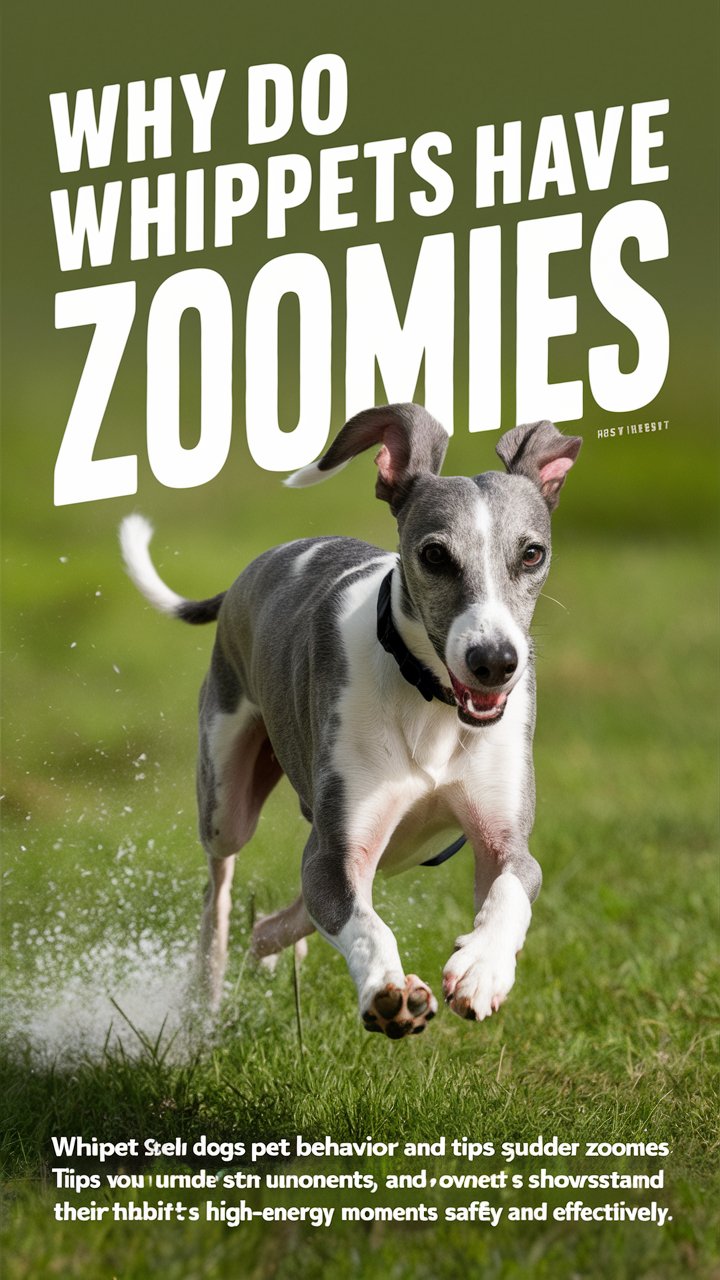Watching your Whippet suddenly zoom around the house, garden, or park can be one of the funniest sights for dog owners. These bursts of energy, commonly known as the “zoomies” or scientifically Frenetic Random Activity Periods (FRAPs), are completely normal – but there’s a lot more going on than just random fun.
In this complete guide, you’ll learn:
✅ The real science behind why Whippets get zoomies.
✅ Hidden triggers that most owners miss.
✅ Potential health concerns linked to excessive zoomies.
✅ Pro training and lifestyle tips to manage zoomies safely.
✅ FAQs every Whippet parent asks.
Let’s dive in.
🐕 What Are Zoomies in Whippets?
Zoomies are sudden bursts of uncontrollable energy where your Whippet may sprint in circles, dart across rooms, or bounce around wildly. While they look funny (and sometimes chaotic), they are actually a healthy way for Whippets to:
- Burn off pent-up physical energy
- Release emotional stress or excitement
- Practice natural prey-chasing instincts (since Whippets are sighthounds)
Fact: Zoomies are more common in puppies and young Whippets, but adults can still get them, especially when overstimulated or under-exercised.
🔍 Top Reasons Why Whippets Get Zoomies
1. Pent-Up Energy
Whippets are sprinters by nature. If they don’t get enough daily exercise (at least 60–90 minutes), energy builds up and explodes in the form of zoomies.
Pro Tip: A tired Whippet is a happy Whippet. Structured exercise like fetch, agility, or controlled sprint sessions reduces excessive zoomies indoors.
2. Pure Excitement
Many Whippets zoom when they see their leash, favorite toy, or their human after hours of separation. This is their way of expressing joy.
Puppies are especially prone to “excitement zoomies” because everything feels new and stimulating.
3. Anxiety or Stress Release
Zoomies aren’t always fun-based. Sometimes they’re a coping mechanism when a Whippet feels anxious (new environments, unfamiliar people, vet visits).
Weak Point in Many Articles: Most guides don’t explain the difference between happy zoomies and anxiety-driven zoomies. Identifying the trigger is key.
4. Learned/Rewarded Behavior
If your Whippet notices that zooming gets your attention (whether you laugh, chase, or call their name), they may repeat it more often. Dogs don’t distinguish between positive or negative attention—they just love attention.
5. Instinctual Pack Copying
Whippets may mimic other dogs or even high-energy humans. If another dog zooms, your Whippet will likely join in because contagious energy is part of their pack instinct.
6. Environmental Triggers (Advanced Insight)
Whippets often zoom after specific events like:
- After a bath (relief + refreshed feeling)
- After pooping (natural body release + excitement)
- At dusk or dawn (crepuscular energy spikes)
- During weather changes (cold air can stimulate bursts of energy)
⚠️ When Zoomies Might Signal a Problem
Zoomies are usually harmless, but in rare cases they can point to underlying issues:
- Excessive, nonstop zoomies → May indicate hyperactivity disorder or poor lifestyle balance.
- Zoomies with whining, pacing, or tail-tucking → Likely stress-driven and not just play.
- Zoomies followed by limping → Could be joint/muscle strain.
If your Whippet’s zoomies seem unusual, consult a vet or canine behaviorist.
🛠️ 5 Pro Tips To Manage & Control Whippet Zoomies
1. Structured Exercise Routine 🏃♂️
Whippets need both sprinting opportunities and mental stimulation. Daily walks alone aren’t enough. Mix in:
- Off-leash runs (in safe enclosed areas)
- Fetch or lure-coursing games
- Puzzle toys for mental energy release
2. Identify & Control Triggers 🎯
Keep a diary of when zoomies happen: morning, after meals, during play, or after baths. Once you find the trigger, you can manage it better.
3. Create a Safe Zoom Zone 🏡
Clear space indoors or outdoors where your Whippet can zoom without knocking things over or hurting themselves. Whippets are fragile, with slim legs prone to injury.
4. Teach “Settle” & Impulse Control 🧘♀️
Training commands like “Settle”, “Stay”, or “Mat” helps redirect energy. Reward calmness so zoomies don’t become the only outlet.
5. Balance Physical & Emotional Health ❤️
Remember, zoomies aren’t just physical. Enrichment like chew toys, sniff walks, and gentle bonding time reduces stress-driven zoomies.
❓ FAQs
Q: What age do Whippets stop getting zoomies?
Most calm down between 1–2 years, but occasional zoomies can last for life.
Q: Why after a bath?
Because it relieves anxiety → followed by joy & freshness.
Q: Why after pooping?
It’s partly physical relief, partly instinctual celebration.
Q: Should I stop zoomies?
No, unless they’re unsafe. Redirect to a secure area instead.
🌟 Final Thoughts
Zoomies in Whippets are a natural, healthy, and often hilarious behavior. Instead of seeing them as “crazy energy,” understand them as your Whippet’s way of expressing life, joy, or emotions.
By balancing exercise, emotional well-being, and training, you can make zoomies safe, controlled, and less frequent indoors—while still letting your pup enjoy their bursts of happiness.
